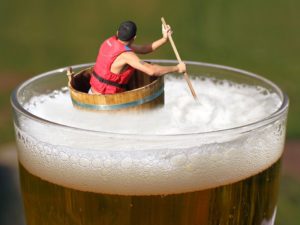I know, timing, huh?! It’s almost like I’ve been sniffing around your recycling bins but I didn’t need to of course, at this time of year it’s a fairly safe bet you’re madly winding it back a tad from your most outrageous annual alcohol imbibing. And so are all our patients. To me, extracting accurate information succinctly from patients regarding their alcohol use can be one slippery little sucker. It’s one of the questions people tend to give you a very tidied up answer to, or in fact they’re in such denial they can’t be considered a reliable witness. Think about it. Being a non-habitual drinker myself, I can appear almost saintly when reporting my daily consumption, “None”…but that omits the ‘other me’ that might show up at a conference gala dinner or some live music event, with my volume controls adjusted significantly up…ergh…firsthand accounts anyone? And how often does that happen? Well anywhere between 4 times a week and once a month. See what I mean?
While I’m sure you’ve probably heard me say before, I ask every patient who does drink, what kind of drunk they are because it can hint at their underlying neurobiology, there is a new study that suggests, using a very short 4 item UCLA RRHDS survey, we can categorise patients alcohol use and misuse into 3 types:
Reward Relief Habit
and in doing so, also be better able to identify the best way to manage them as well.
I’ve been interested in addiction neurobiology for a long time and very much resonate with the work of Koob, which in layman’s terms proposes that we seek intoxication initially for the ‘high’ and then with dependence, we continue to seek it to appease the terrible lows of withdrawal. It has long been known that alcohol use disorder is heterogeneous – there are different types and accordingly the kind of generalised treatment of these individuals proves extremely hit and miss. But articulating the different types and their distinct drivers and solutions has been fraught. Like what makes one alcoholic the functional type who in addition to their long-lunches is a CEO and the one who can’t keep their job? Is it just socioeconomic context or something more? Why are some types of alcoholism deemed also to run more in families and while others aren’t? There are clearly major difference in pathophysiology but what are they? More recently these 3 groups have emerged and this recent study confirms the value particularly in the distinction between those who drink driven by reward and those for relief + habit. It’s a great read but here are some key take-homes:
Relief Habit
Relief/Habit: You predominantly drink to cope with, or resolve a negative physical and emotional experience (negative reinforcement). You have more depressive features and have more anxious traits than those ‘reward drinkers’. The key to managing this type of pattern is to target negative physical and psychological experiences with ‘downers’ (they calm down an overactive brain that’s on ‘alert’) such as sedatives, anxiolytics, and glutamatergic modulation. (Hint for practitioners: this is where Taurine & Glycine really shine)
Reward
These individuals drink to feel good so they are driven by positive reinforcement and therefore the approach to the helping them should be quite different, with lifestyle recommendations that offer other options for mood elevation such as exercise etc as well and herbal and nutritional approaches.( Hint hint…not the key group for Taurine, more like Tyrosine and Saffron etc)
So…back to my question…what kind of drunk are you & what drives you to drink? As a nation of over-consumers by nature, this is a question we need to ask all our patients
Mastering Mental Health: New Assessments and Management Resources in Your Clinic (2hrs)
Rachel introduces you to new clinical tools that has been developing to help us all better master the maze of mental health. With so many possible biological drivers: from methylation to inflammation and from gonads to gut, these tools can help you quickly identify those most relevant to each patient and also outline the strategies necessary for redressing these. This presentation comes with an extensive library of resources including pdf of Assessments Tools and Case Study Notes.

